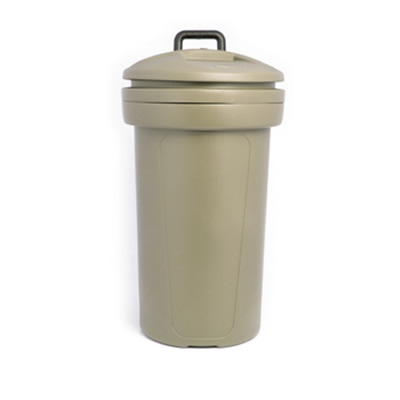Incineration is a method of reducing waste products to inert ash. In general, most incinerated items will be less than 10% of their original bulk...
Security / cheques / currency incinerator- Security documents, drawings and currency (soiled or rejected) cannot go out of an establishment’s...
Old » The process of burning, setting fire to or destroying.
New » An engineered process using controlled flame combustion to thermally degrade waste materials.
Incinerators of today are designed to efficiently and safely burn wastes at specified rates and temperatures with the residual ash containing little or no combustible material.
An incinerator must have the following design features:
a. Mixing of air and fuel should be in the correct proportion.
b. The 3Ts of incineration must be achieved - high retention Time for complete combustion, provision for creation of Turbulence in the incinerator's combustion chambers and appropriate Temperatures.
c. Should be easy to install and simple to operate
d. Satisfy all environmental regulations.
An incinerator can help you dispose biomedical, hazardous, animal, vegetable and other types of waste materials. It is one of the most preferred methods of waste disposal in the world today.
In many locations throughout the world, waste is simply dumped on unused ground where it is left to decompose over time. The decomposing waste provides a breeding ground for vermin and bugs and any human or animal could become seriously ill after coming in contact with decomposing waste. Land-fill sites are also problematic as they are difficult to maintain and need to be specially designed facilities having closely controlled access and operational practices. Shortage of land and underground pollution are also major issues. Risks may also be greater from composting because human exposure to toxic substances is greater through food chain pathways than through inhalation pathways.
Incinerator selection can be done based on the following:
a. Type and quantity of waste being generated per day.
b. Duration that machine will be operated in a day.
c. Fuel to be used.
d. Whether any special loading or de-ashing systems are required.
e. Whether any space restrictions exist.
f. Emission norms to be complied with.
g. Any other specific requirements such as mode of operation, electric supply etc.
More information Types of Incinerators and Selection
Many fly-by-night companies, in order to make a quick buck, produce metal shells, which do not meet temperature or residence time requirements. Some manufacturers fail to mention the high maintenance and running costs of these systems and also their inability to meet temperature requirements. Selection of an incinerator design and company must be made based on past experience, service back-up, reputation of the manufacturer and availability of spares and quality control measures adopted during production.
• Siting in the open is recommended upon level concrete, not close to tall buildings and in an area free from air turbulence. If positioning is within a building, appropriate flue arrangements must be provided and adequate ventilation is essential.
• Ensure adequate space around the incinerator for operation and maintenance of the unit. (This is particularly important if unit is housed inside a building.)
• Do not stand flammable materials or liquids close to incinerators.
• Always allow a minimum of two metres clear space all round the incinerator.
• Concrete hard standing bases must be able to take the weight of the incinerator. They should also be able to withstand the temperature put out by the unit.
• Always ensure sufficient room is available to ash out the unit.
• If sited inside a building, adequate air must be available to ensure the combustion process can take place and sufficient ventilation is allowed for.
• The proposed site should, if possible, be such as to allow for the efficient cost effective operation of the unit.
The answer to this is a very simple 'NO'. The incinerator can only be part of a comprehensive waste management system, of which it is a large component. It can be used for most waste types barring a few exceptions. A plan to reduce, reuse and recycle will go a long way in solving all disposal problems.
Incinerators need to have certain design features and need to be used correctly. Indiscriminate use of inadequately designed systems (by overloading, loading non-incinerable wastes, etc.) and pollution generated by these caused some sectors to label all incinerators as inefficient. However, technologies are available today which have made waste incinerators a clean and environmentally sound form of waste management, so that such opposition is now unfounded. All methods like recycling, composting, land-filling and incineration have similar environmental impacts. Comparison of impacts is difficult because alternative systems generate different pollutants having various toxicities, effects, reasons and modes and affect different populations and eco-systems. It is not possible, for example, to qualitatively determine whether recycling produces more or less pollutants or produces greater or fewer risks per ton of material processed than do incineration or land filling.
A waste management plan will determine which initiatives will be the most beneficial. The three main steps are information gathering, waste stream analysis and development of action plans. Information must be collected on the volume of each type of waste in each specific area and current costs associated with disposal must be determined. Waste management initiatives like reduction, recycling, reuse and recovery will enable treatment of only waste types that need to be treated.
You need to be aware of your local environmental emission standards which will help you to select the right equipment by asking your prospective suppliers to confirm suitability and then compare the equipment configuration. You can also see if these companies are certified to/follow certain standards including ISO, ASME, etc. It would also be prudent to check the track record of a company to see if they have relevant experience.
Satisfy yourself by asking the selected companies to make a presentation of their products and if possible make a visit to their facility, which will help you to decide who is reliable and who to buy from. List out positive points of each supplier and see who scores more. Usually, a company who spends less time talking about his product and more time about the negative points of his competitor is the one to be wary of!
It is neither necessary nor possible to make a new model for every different waste. A similar model with some customisation may work for wastes such as biomedical, garbage and animal waste. This will, however, not be true for hazardous wastes.
It depends on the manufacturing costs, which includes quality standards followed and quality of raw-materials and components used, which contribute to the reliability of the equipment. Equipment can be designed to work for many years (which would cost more). Check if a company has set quality assurance procedures which can ensure that they do not use cheap raw materials or improper production methods.
No, simple training from the supplier will help your operator to operate the incinerator. However, the content of the training programme is critical and some basic aptitude from the operator is needed. Check if the supplier himself has any experience in operation and maintenance of incinerators.
Incineration is a method of reducing waste products to inert ash. In general, most incinerated items will be less than 10% of their original bulk when rendered to ash.
Incineration is being seen more and more as a cost effective and environment friendly method of disposing of many types of wastes. Provided the incinerator is designed and operated in accordance with the manufacturer`s instructions, it is seen as a safe method of waste disposal.
If you consider incineration with other waste disposal solutions, we find `dumping` as one of the most common methods used, a process of choosing unused open ground to deposit waste materials where they are left to decompose over time. This being a health risk, it is an unacceptable solution.
The other practice in most developed countries is to landfill waste. It is illegal to dump or landfill hospital, toxic chemicals, sludge or nuclear waste on landfill sites in many countries. Most landfill sites are specially designed with closely controlled access and operational practices. Unfortunately due to modern packaging, etc. a high proportion of waste being taken to landfill is non-biodegradable and remains a problem. There is also the problem of contamination of underground water ways due to danger of landfill gases and leachate. As a result, many acres of land throughout the world remain poisoned. This issue is being addressed only now.
Considering the above, incineration is the most suitable method of disposing of waste, which has the following advantages:
- Most gases are burnt during incineration process
- Most types of waste are reduced to less than 10% of their volume
- The ash is harmless having been rendered safe.
- Transport costs from point of waste generation to disposal site are dramatically reduced.
In many of the developed and developing nations, rules are already in place for safe incineration of Municipal Solid waste, Bio-medical waste and Hazardous waste. These rules clearly identify specifications for the incinerator and its configuration with identified limits for
What is an incinerator?
It is an engineered apparatus capable of safely burning waste materials, at the same time, designed to withstand heat and effectively reduce recognized types of wastes at specified rates and from which the residuum ash contains little or no combustible material. Additionally, with specific downstream Air Pollution Control equipment, the incinerator releases emission of gases such as, CO, CO2, NOx, SOx etc. along with PM, which are safe to the environment and human beings.
What makes one type or make of incinerator better than another?
The design parameters considered including and particularly the thermal values, the type and thickness of refractory, residence time of gases, quality of construction and production equipment used, surface preparation and thickness and layers of paints used, its reliability, efficiency and service life for which it is designed.
Many alternative methods for waste disposal are available, but incinerators today offer cleaner disposal methods with possibilities of energy recovery and emissions being cleaner than vehicular or other emissions that we come across every day.
An incinerator is also not the only answer to disposal of all types of waste. An incinerator should be part of a comprehensive waste management system in which it plays a large role.
Contagious animal diseases or mad cow diseases - WHO says, "Prevention of anthrax in both humans and animals is based on control measures in livestock in endemic areas, such as the safe disposal of anthrax carcasses and vaccination of at-risk herds. The most efficient method of disposal is incineration". The Haat Incinerator best suited for handling this type of waste can be found here - MODEL ANIMAL CREMATOR / INCINERATOR
The 3 R’s are critical in overall waste management and handling.
A few typical examples of where using an incinerator is the ideal solution:
“Haat can be relied on to meet urgent requirements.” – Sanjay Tulshyan, Managing Director, Technical Associates, Nepal.







